Abstract
This limited review of the early studies on the activation of the N-aryl carcinogens was written to provide a background for the current research to be presented at this conference on carcinogenesis by N-aryl compounds. Since the work of the past 10 years is too recent to be judged in a historical sense and because those data are much better known by current investigators, this review is generally limited to data up to 1972.
Full text
PDF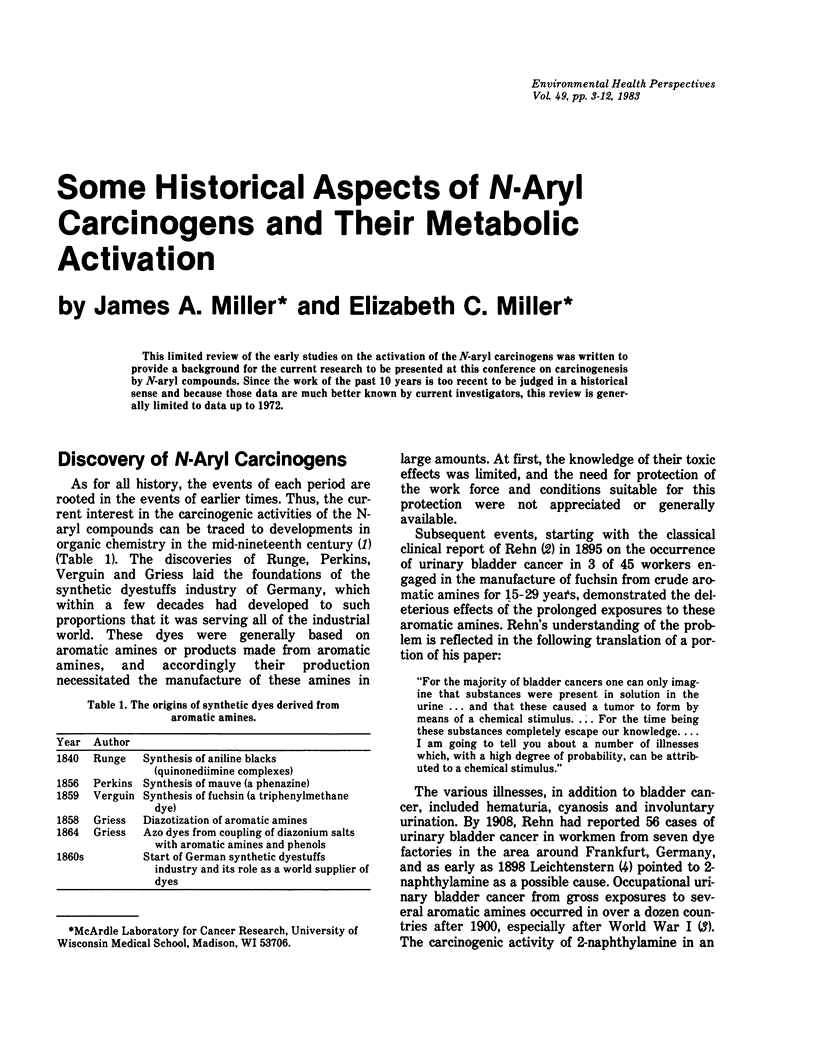
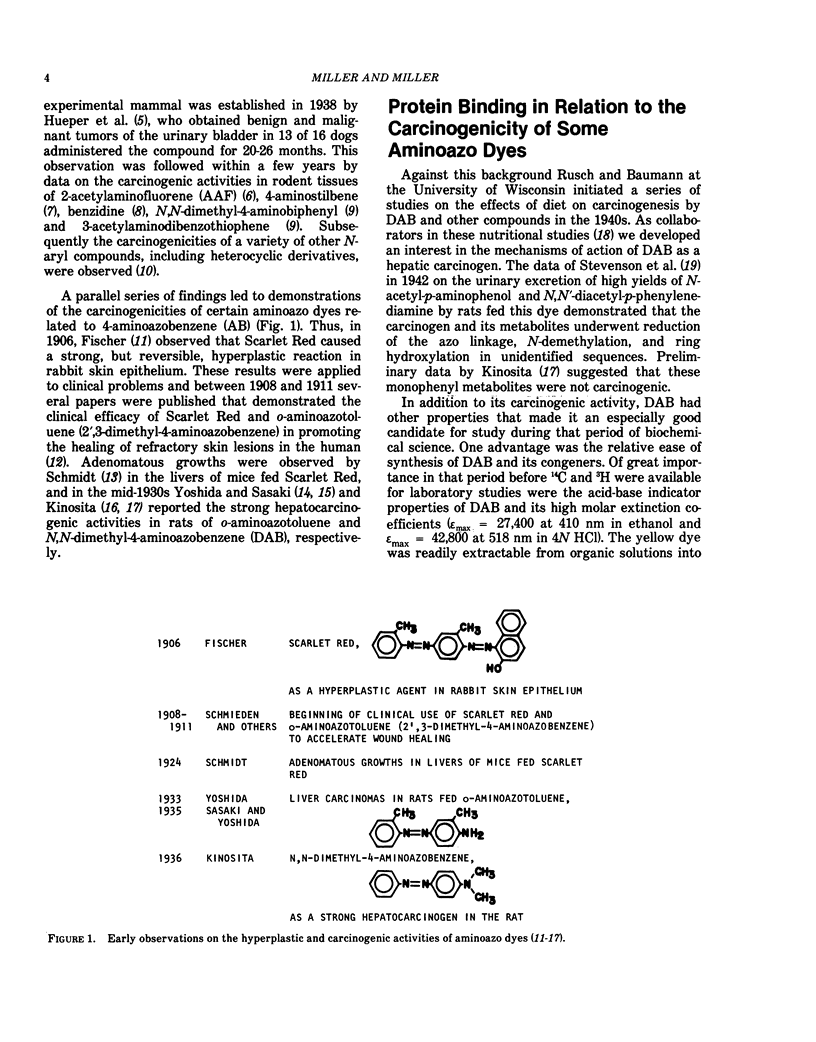

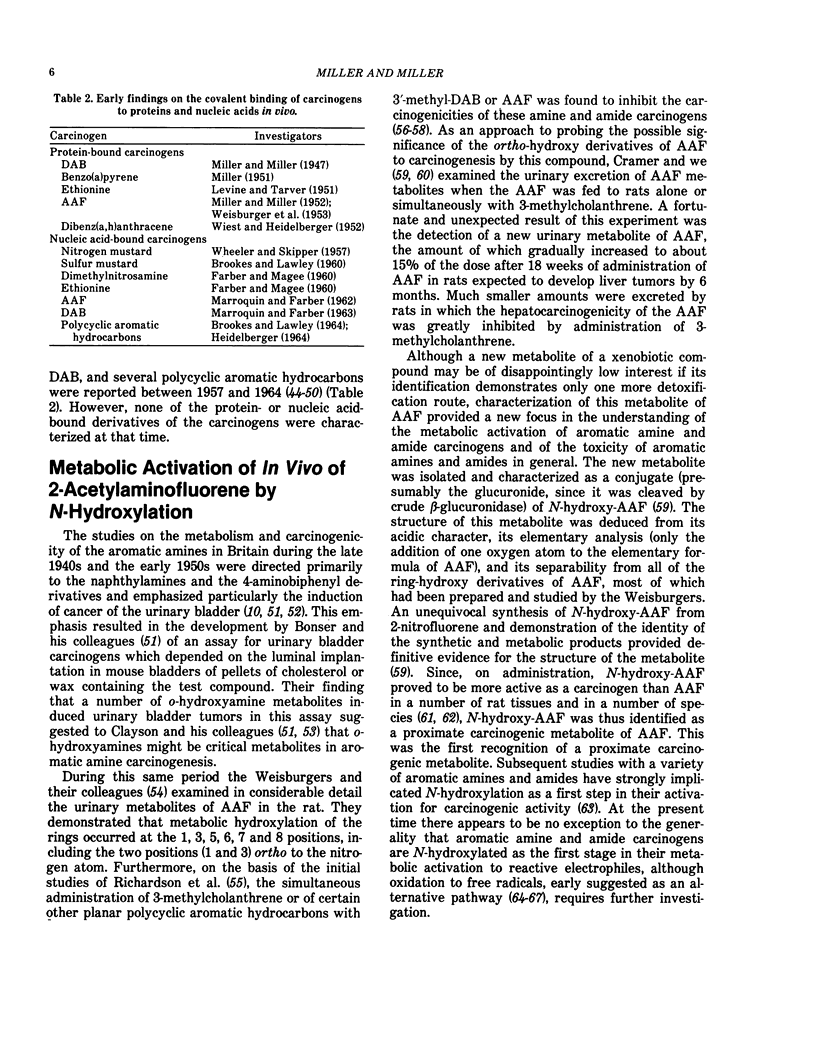
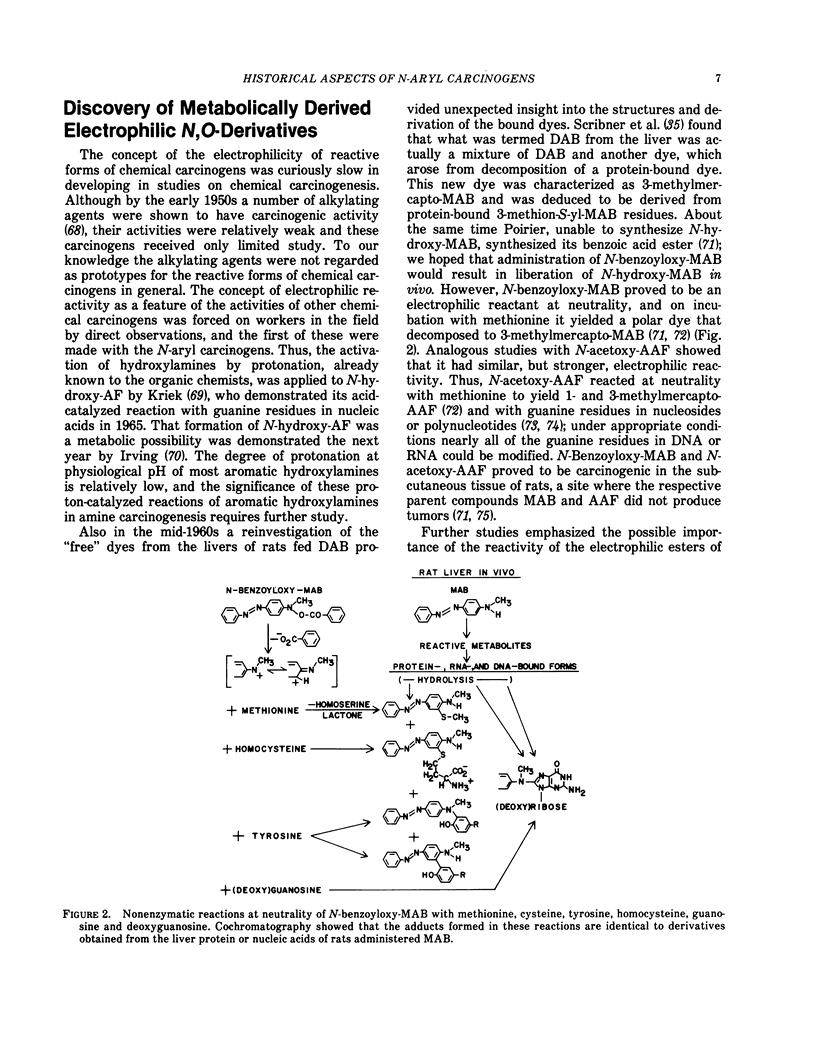
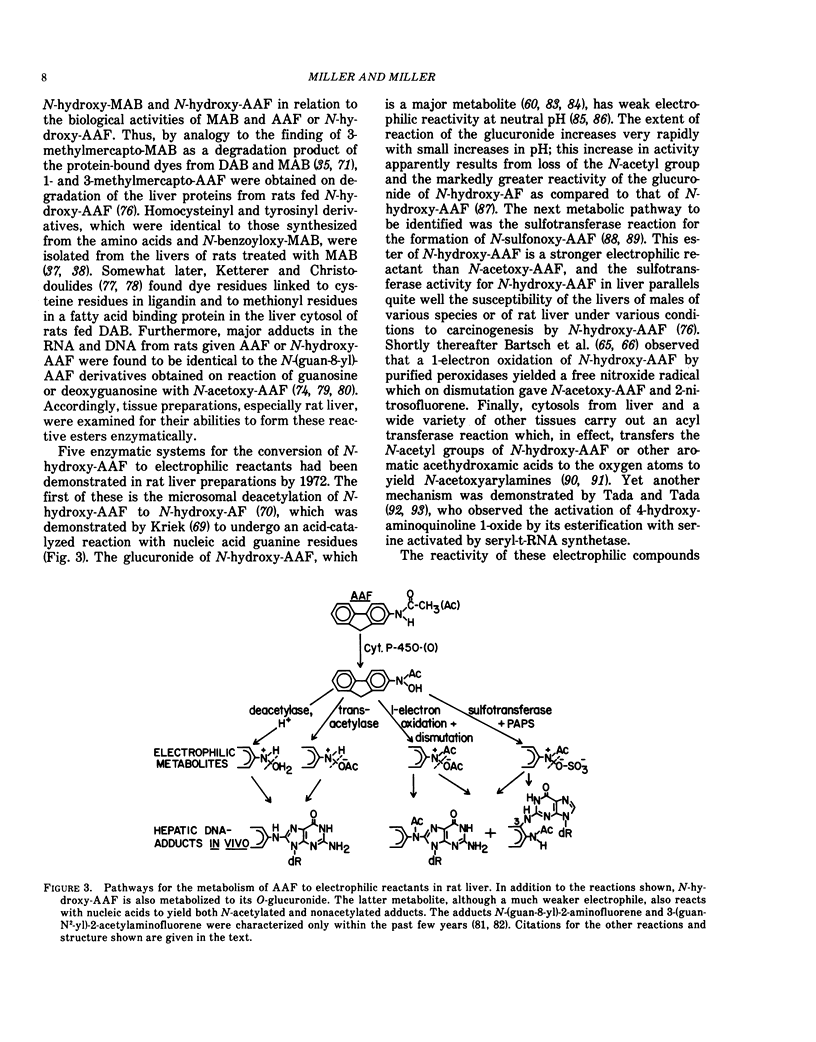
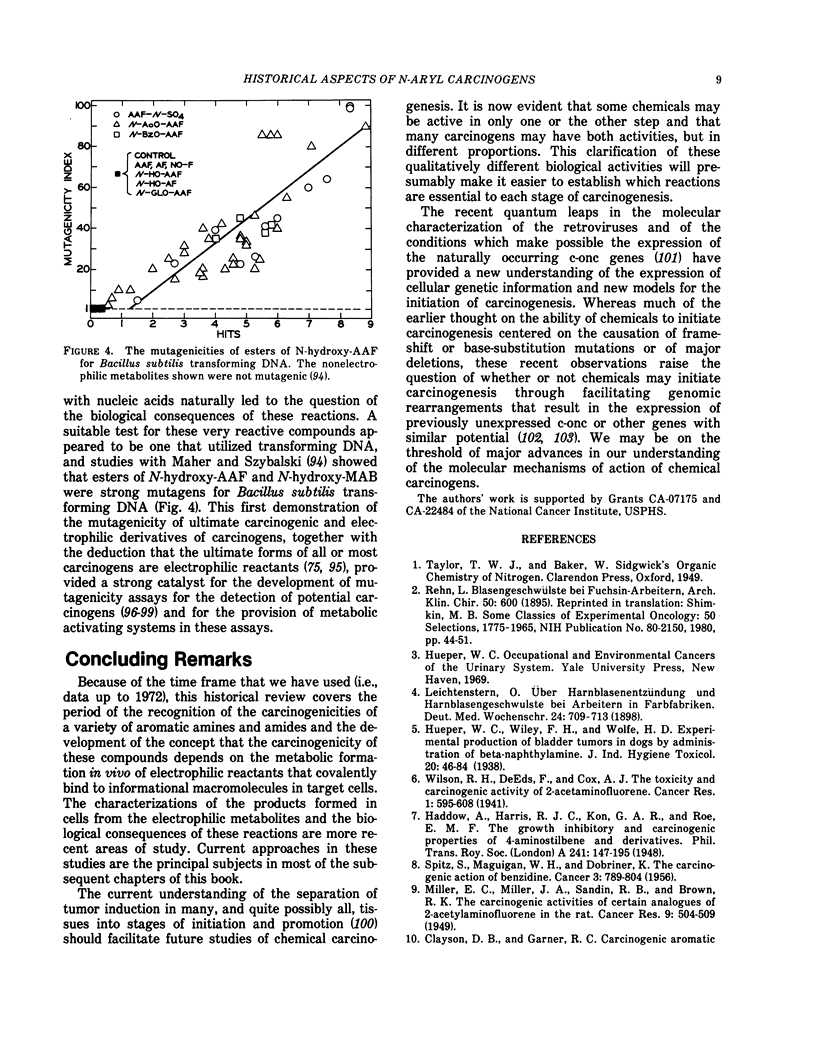
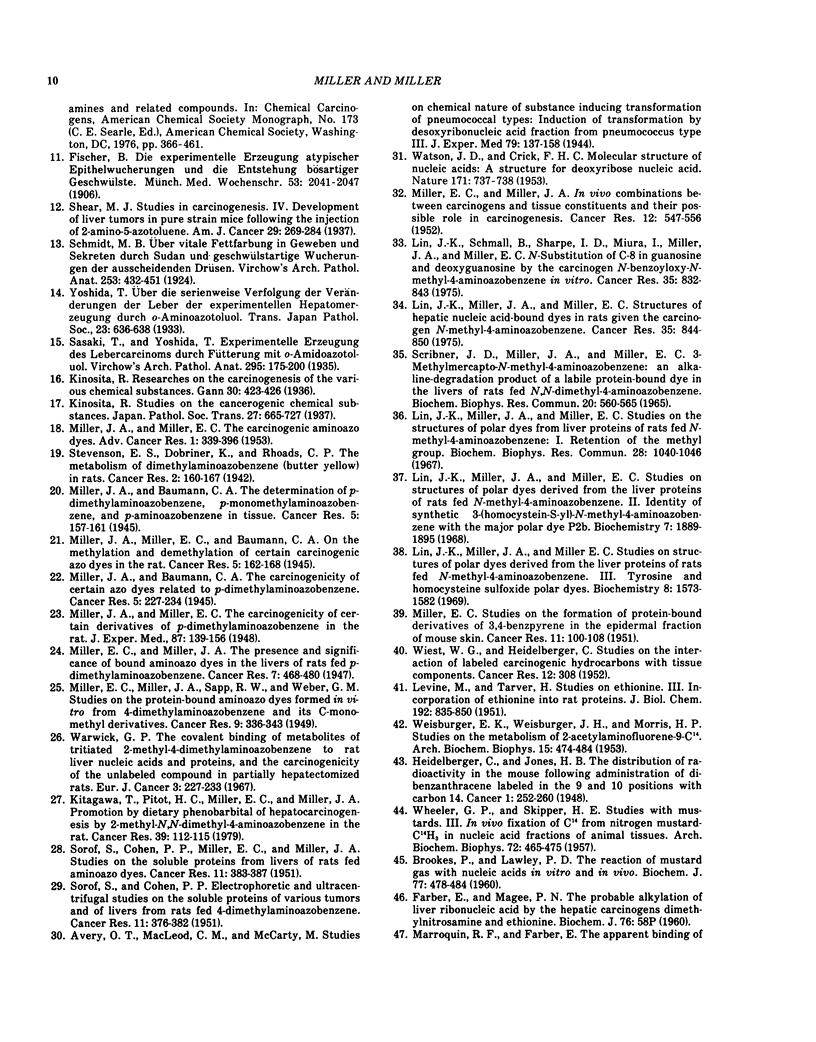
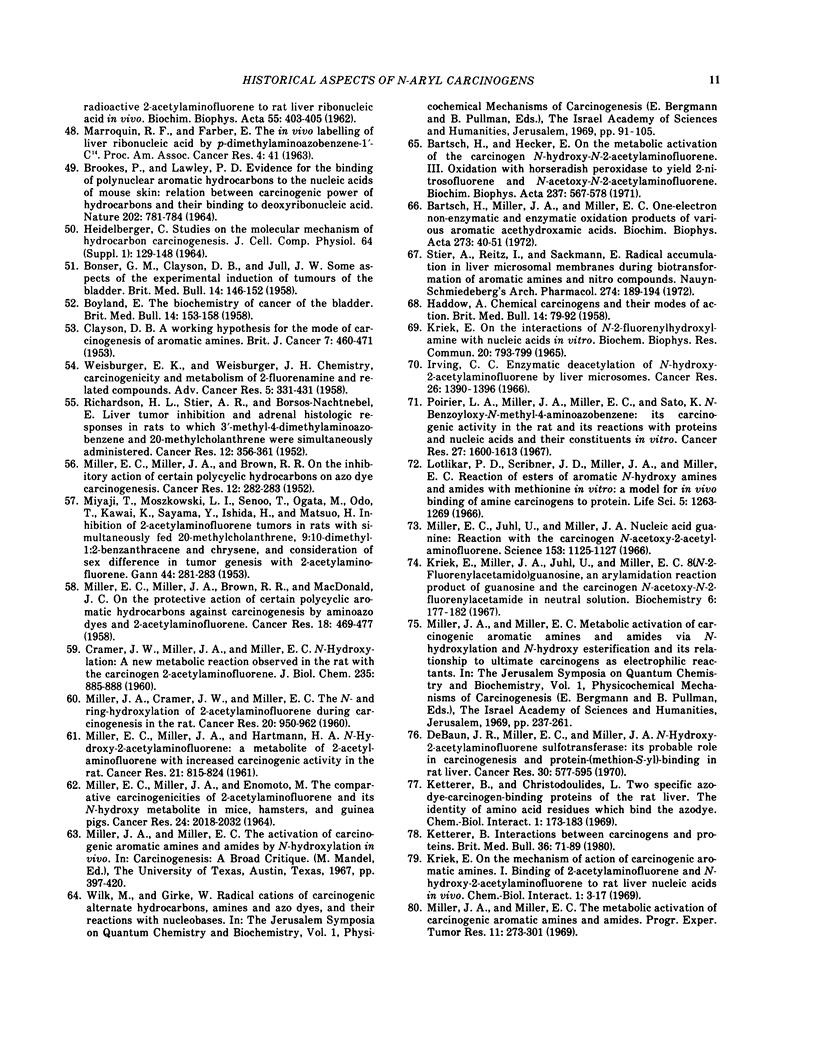
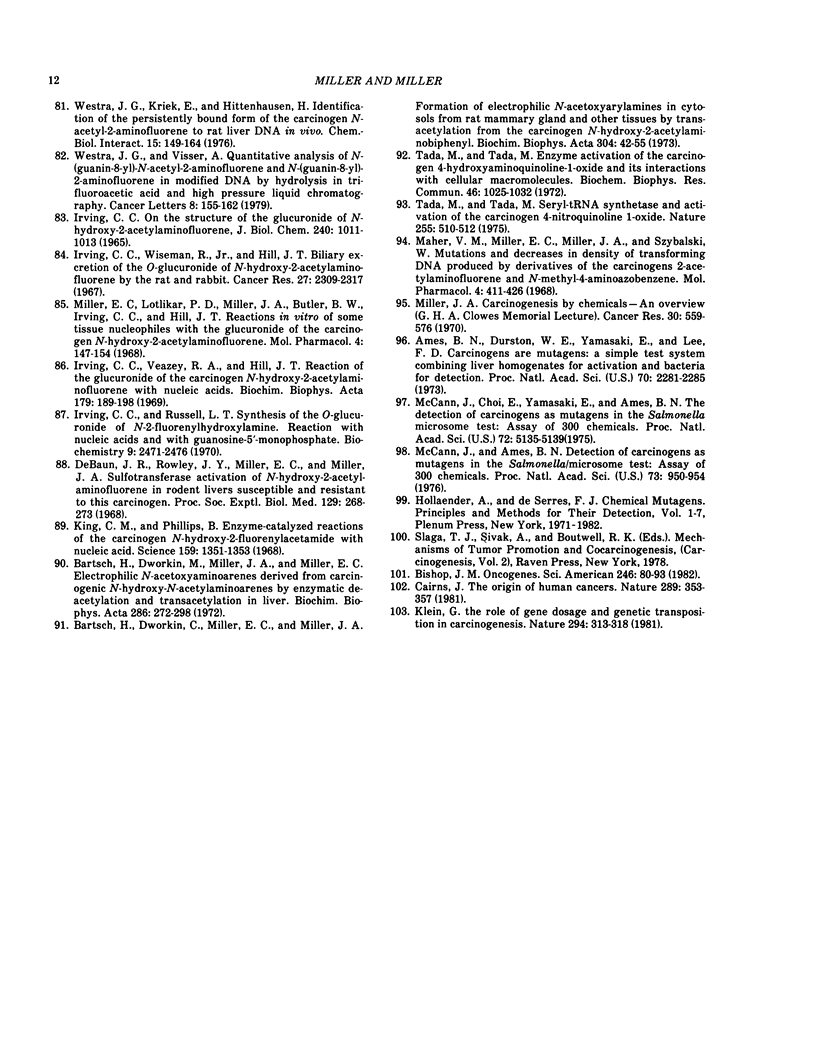
Selected References
These references are in PubMed. This may not be the complete list of references from this article.
- Ames B. N., Durston W. E., Yamasaki E., Lee F. D. Carcinogens are mutagens: a simple test system combining liver homogenates for activation and bacteria for detection. Proc Natl Acad Sci U S A. 1973 Aug;70(8):2281–2285. doi: 10.1073/pnas.70.8.2281. [DOI] [PMC free article] [PubMed] [Google Scholar]
- BONSER G. M., CLAYSON D. B., JULL J. W. Some aspects of the experimental induction of tumours of the bladder. Br Med Bull. 1958 May;14(2):146–152. doi: 10.1093/oxfordjournals.bmb.a069658. [DOI] [PubMed] [Google Scholar]
- BOYLAND E. The biochemistry of cancer of the bladder. Br Med Bull. 1958 May;14(2):153–158. doi: 10.1093/oxfordjournals.bmb.a069659. [DOI] [PubMed] [Google Scholar]
- BROOKES P., LAWLEY P. D. EVIDENCE FOR THE BINDING OF POLYNUCLEAR AROMATIC HYDROCARBONS TO THE NUCLEIC ACIDS OF MOUSE SKIN: RELATION BETWEEN CARCINOGENIC POWER OF HYDROCARBONS AND THEIR BINDING TO DEOXYRIBONUCLEIC ACID. Nature. 1964 May 23;202:781–784. doi: 10.1038/202781a0. [DOI] [PubMed] [Google Scholar]
- Bartsch H., Dworkin C., Miller E. C., Miller J. A. Formation of electrophilic N-acetoxyarylamines in cytosoles from rat mammary gland and other tissues by transacetylation from the carcinogen N-hydroxy-4-acetylaminobiphenyl. Biochim Biophys Acta. 1973 Mar 30;304(1):42–55. doi: 10.1016/0304-4165(73)90113-x. [DOI] [PubMed] [Google Scholar]
- Bartsch H., Dworkin M., Miller J. A., Miller E. C. Electrophilic N-acetoxyaminoarenes derived from carcinogenic N-hydroxy-N-acetylaminoarenes by enzymatic deacetylation and transacetylation in liver. Biochim Biophys Acta. 1972 Dec 29;286(2):272–298. doi: 10.1016/0304-4165(72)90265-6. [DOI] [PubMed] [Google Scholar]
- Bartsch H., Hecker E. On the metabolic activation of the carcinogen N-hydroxy-N-2-acetylaminofluorene. 3. Oxidation with horseradish peroxidase to yield 2-nitrosofluorene and N-acetoxy-N-2-acetylaminofluorene. Biochim Biophys Acta. 1971 Jun 22;237(3):567–578. doi: 10.1016/0304-4165(71)90277-7. [DOI] [PubMed] [Google Scholar]
- Bartsch H., Miller J. A., Miller E. C. N-acetoxy-N-acetylaminoarenes and nitrosoarenes. One-electron non-enzymatic and enzymatic oxidation products of various carcinogenic aromatic acethydroxamic acids. Biochim Biophys Acta. 1972 Jun 26;273(1):40–51. doi: 10.1016/0304-4165(72)90189-4. [DOI] [PubMed] [Google Scholar]
- Bishop J. M. Oncogenes. Sci Am. 1982 Mar;246(3):80–92. doi: 10.1038/scientificamerican0382-80. [DOI] [PubMed] [Google Scholar]
- Brookes P., Lawley P. D. The reaction of mustard gas with nucleic acids in vitro and in vivo. Biochem J. 1960 Dec;77(3):478–484. doi: 10.1042/bj0770478. [DOI] [PMC free article] [PubMed] [Google Scholar]
- CLAYSON D. B. A working hypothesis for the mode of carcinogenesis of aromatic amines. Br J Cancer. 1953 Dec;7(4):460–471. doi: 10.1038/bjc.1953.48. [DOI] [PMC free article] [PubMed] [Google Scholar]
- CRAMER J. W., MILLER J. A., MILLER E. C. N-Hydroxylation: A new metabolic reaction observed in the rat with the carcinogen 2-acetylaminofluorene. J Biol Chem. 1960 Mar;235:885–888. [PubMed] [Google Scholar]
- Cairns J. The origin of human cancers. Nature. 1981 Jan 29;289(5796):353–357. doi: 10.1038/289353a0. [DOI] [PubMed] [Google Scholar]
- DeBaun J. R., Miller E. C., Miller J. A. N-hydroxy-2-acetylaminofluorene sulfotransferase: its probable role in carcinogenesis and in protein-(methion-S-yl) binding in rat liver. Cancer Res. 1970 Mar;30(3):577–595. [PubMed] [Google Scholar]
- DeBaun J. R., Rowley J. Y., Miller E. C., Miller J. A. Sulfotransferase activation of N-hydroxy-2-acetylaminofluorene in rodent livers susceptible and resistant to this carcinogen. Proc Soc Exp Biol Med. 1968 Oct;129(1):268–273. doi: 10.3181/00379727-129-33301. [DOI] [PubMed] [Google Scholar]
- HADDOW A. Chemical carcinogens and their modes of action. Br Med Bull. 1958 May;14(2):79–92. doi: 10.1093/oxfordjournals.bmb.a069680. [DOI] [PubMed] [Google Scholar]
- HEIDELBERGER C. STUDIES ON THE MOLECULAR MECHANISM OF HYDROCARBON CARCINOGENESIS. J Cell Physiol. 1964 Oct;64:SUPPL 1–1:148. [PubMed] [Google Scholar]
- IRVING C. C. ON THE STRUCTURE OF THE GLUCURONIDE OF N-HYDROXY-2-ACETYLAMINOFLUORENE. J Biol Chem. 1965 Mar;240:1011–1013. [PubMed] [Google Scholar]
- Irving C. C. Enzymatic deacetylation of N-hydroxy-2-acetylaminofluorene by liver microsomes. Cancer Res. 1966 Jul;26(7):1390–1396. [PubMed] [Google Scholar]
- Irving C. C., Russell L. T. Synthesis of the O-glucuronide of N-2-fluorenylhydroxylamine. Reaction with nucleic acids and with guanosine 5'-monophosphate. Biochemistry. 1970 Jun 9;9(12):2471–2476. doi: 10.1021/bi00814a012. [DOI] [PubMed] [Google Scholar]
- Irving C. C., Veazey R. A., Hill J. T. Reaction of the glucuronide of the carcinogen N-hydroxy-2-acetylaminofluorene with nucleic acids. Biochim Biophys Acta. 1969 Mar 18;179(1):189–198. doi: 10.1016/0005-2787(69)90135-x. [DOI] [PubMed] [Google Scholar]
- Irving C. C., Wiseman R., Jr, Hill J. T. Biliary excretion of the O-glucuronide of N-hydroxy-2-acetylamino-fluorene by the rat and rabbit. Cancer Res. 1967 Dec;27(12):2309–2317. [PubMed] [Google Scholar]
- Ketterer B., Christodoulides L. Two specific azodye-carcinogen-binding proteins of the rat liver. The identity of amino acid residues which bind the azodye. Chem Biol Interact. 1969 Dec;1(2):173–183. doi: 10.1016/0009-2797(69)90005-2. [DOI] [PubMed] [Google Scholar]
- Ketterer B. INteractions between carcinogens and proteins. Br Med Bull. 1980 Jan;36(1):71–78. doi: 10.1093/oxfordjournals.bmb.a071617. [DOI] [PubMed] [Google Scholar]
- King C. M., Phillips B. Enzyme-catalyzed reactions of the carcinogen N-hydroxy-2-fluorenylacetamide with nucleic acid. Science. 1968 Mar 22;159(3821):1351–1353. doi: 10.1126/science.159.3821.1351. [DOI] [PubMed] [Google Scholar]
- Kitagawa T., Pitot H. C., Miller E. C., Miller J. A. Promotion by dietary phenobarbital of hepatocarcinogenesis by 2-methyl-N,N-dimethyl-4-aminoazobenzene in the rat. Cancer Res. 1979 Jan;39(1):112–115. [PubMed] [Google Scholar]
- Klein G. The role of gene dosage and genetic transpositions in carcinogenesis. Nature. 1981 Nov 26;294(5839):313–318. doi: 10.1038/294313a0. [DOI] [PubMed] [Google Scholar]
- Kriek E., Miller J. A., Juhl U., Miller E. C. 8-(N-2-fluorenylacetamido)guanosine, an arylamidation reaction product of guanosine and the carcinogen N-acetoxy-N-2-fluorenylacetamide in neutral solution. Biochemistry. 1967 Jan;6(1):177–182. doi: 10.1021/bi00853a029. [DOI] [PubMed] [Google Scholar]
- Kriek E. On the interaction of N-2-fluorenylhydroxylamine with nucleic acids in vitro. Biochem Biophys Res Commun. 1965 Sep 22;20(6):793–799. doi: 10.1016/0006-291x(65)90088-4. [DOI] [PubMed] [Google Scholar]
- Kriek E. On the mechanism of action of carcinogenic aromatic amines. I. Binding of 2-acetylaminofluorene and N-hydroxy-2-acetylaminofluorene to rat-liver nucleic acids in vivo. Chem Biol Interact. 1969 Oct;1(1):3–17. doi: 10.1016/0009-2797(69)90015-5. [DOI] [PubMed] [Google Scholar]
- LEVINE M., TARVER H. Studies on ethionine. III. Incorporation of ethionine into rat proteins. J Biol Chem. 1951 Oct;192(2):835–850. [PubMed] [Google Scholar]
- Lin J. K., Miller J. A., Miller E. C. Structures of hepatic nucleic acid-bound dyes in rats given the carcinogen N-methyl-4-aminoazobenzene. Cancer Res. 1975 Mar;35(3):844–850. [PubMed] [Google Scholar]
- Lin J. K., Miller J. A., Miller E. C. Studies on structures of polar dyes derived from the liver proteins of rats fed N-methyl-4-aminoazobenzene. 3. Tyrosine and homocysteine sulfoxide polar dyes. Biochemistry. 1969 Apr;8(4):1573–1582. doi: 10.1021/bi00832a037. [DOI] [PubMed] [Google Scholar]
- Lin J. K., Miller J. A., Miller E. C. Studies on structures of polar dyes derived from the liver proteins of rats fed N-methyl-4-aminoazobenzene. II. Identity of synthetic 3-(homocystein-S-yl)-N-methyl-4-aminoazobenzene with the major polar dye P2b. Biochemistry. 1968 May;7(5):1889–1895. doi: 10.1021/bi00845a037. [DOI] [PubMed] [Google Scholar]
- Lin J. K., Miller J. A., Miller E. C. Studies on the structures of polar dyes from liver proteins of rats fed N-methyl-4-aminoazobenzene: I. Retention of the methyl group. Biochem Biophys Res Commun. 1967 Sep 27;28(6):1040–1046. doi: 10.1016/0006-291x(67)90087-3. [DOI] [PubMed] [Google Scholar]
- Lin J. K., Schmall B., Sharpe I. D., Miura I., Miller J. A., Miller E. C. N-substitution of carbon 8 in guanosine and deoxyguanosine by the carcinogen N-benzoyloxy-N-methyl-4-aminoazobenzene in vitro. Cancer Res. 1975 Mar;35(3):832–843. [PubMed] [Google Scholar]
- MARROQUIN F., FARBER E. The apparent binding of radioactive 2-acetylaminofluorene to rat-liver ribonucleic acid in vivo. Biochim Biophys Acta. 1962 Mar 5;55:403–405. doi: 10.1016/0006-3002(62)90802-8. [DOI] [PubMed] [Google Scholar]
- MILLER E. C., MILLER J. A., BROWN R. R., MACDONALD J. C. On the protective action of certain polycyclic aromatic hydrocarbons against carcinogenesis by aminoazo dyes and 2-acetylaminofluorene. Cancer Res. 1958 May;18(4):469–477. [PubMed] [Google Scholar]
- MILLER E. C., MILLER J. A., ENOMOTO M. THE COMPARATIVE CARCINOGENICITIES OF 2-ACETYLAMINOFLUORENE AND ITS N-HYDROXY METABOLITE IN MICE, HAMSTERS, AND GUINEA PIGS. Cancer Res. 1964 Dec;24:2018–2031. [PubMed] [Google Scholar]
- MILLER E. C., MILLER J. A., HARTMANN H. A. N-Hydroxy-2-acetylaminofluorene: a metabolite of 2-acetylaminofluorene with increased carcinogenic activity in the rat. Cancer Res. 1961 Jul;21:815–824. [PubMed] [Google Scholar]
- MILLER E. C., MILLER J. A. In vivo combinations between carcinogens and tissue constituents and their possible role in carcinogenesis. Cancer Res. 1952 Aug;12(8):547–556. [PubMed] [Google Scholar]
- MILLER E. C. Studies on the formation of protein-bound derivatives of 3,4-benzpyrene in the epidermal fraction of mouse skin. Cancer Res. 1951 Feb;11(2):100–108. [PubMed] [Google Scholar]
- MILLER J. A., CRAMER J. W., MILLER E. C. The N- and ringhydroxylation of 2-acetylaminofluorene during carcinogenesis in the rat. Cancer Res. 1960 Jul;20:950–962. [PubMed] [Google Scholar]
- MILLER J. A., MILLER E. C. The carcinogenic aminoazo dyes. Adv Cancer Res. 1953;1:339–396. doi: 10.1016/s0065-230x(08)60007-x. [DOI] [PubMed] [Google Scholar]
- MIYAJI T., MOSZKOWSKI L. I., SENOO T., OGATA M., ODA T., KAWAI K., SAYAMA Y., ISHIDA H., MATSUO H. [Inhibition of 2-acetylaminofluorene tumors in rats with simultaneously fed 20-methylcholanthrene, 9:10-dimethyl-1:2-benzanthracene and chrysene, and consideration of sex difference in tumor genesis with 2-acetyl-aminoflurene]. Gan. 1953 Sep;44(2-3):281–283. [PubMed] [Google Scholar]
- Maher V. M., Miller E. C., Miller J. A., Szybalski W. Mutations and decreases in density of transforming DNA produced by derivatives of the carcinogens 2-acetyl-aminofluorene and N-methyl-4-aminoazobenzene. Mol Pharmacol. 1968 Sep;4(5):411–426. [PubMed] [Google Scholar]
- McCann J., Ames B. N. Detection of carcinogens as mutagens in the Salmonella/microsome test: assay of 300 chemicals: discussion. Proc Natl Acad Sci U S A. 1976 Mar;73(3):950–954. doi: 10.1073/pnas.73.3.950. [DOI] [PMC free article] [PubMed] [Google Scholar]
- McCann J., Choi E., Yamasaki E., Ames B. N. Detection of carcinogens as mutagens in the Salmonella/microsome test: assay of 300 chemicals. Proc Natl Acad Sci U S A. 1975 Dec;72(12):5135–5139. doi: 10.1073/pnas.72.12.5135. [DOI] [PMC free article] [PubMed] [Google Scholar]
- Miller E. C., Juhl U., Miller J. A. Nucleic acid guanine: reaction with the carcinogen N-acetoxy-2-acetylaminofluorene. Science. 1966 Sep 2;153(3740):1125–1127. doi: 10.1126/science.153.3740.1125. [DOI] [PubMed] [Google Scholar]
- Miller E. C., Lotlikar P. D., Miller J. A., Butler B. W., Irving C. C., Hill J. T. Reactions in vitro of some tissue nucleophiles with the glucuronide of the carcinogen N-hydroxy-2-acetylaminofluorene. Mol Pharmacol. 1968 Mar;4(2):147–154. [PubMed] [Google Scholar]
- Miller J. A. Carcinogenesis by chemicals: an overview--G. H. A. Clowes memorial lecture. Cancer Res. 1970 Mar;30(3):559–576. [PubMed] [Google Scholar]
- Miller J. A., Miller E. C. The metabolic activation of carcinogenic aromatic amines and amides. Prog Exp Tumor Res. 1969;11:273–301. doi: 10.1159/000391399. [DOI] [PubMed] [Google Scholar]
- Poirier L. A., Miller J. A., Miller E. C., Sato K. N-Benzoyloxy-N-methyl-4-aminoazobenzene: its carcinogenic activity in the rat and its reactions with proteins and nucleic acids and their constituents in vitro. Cancer Res. 1967 Sep;27(9):1600–1613. [PubMed] [Google Scholar]
- RICHARDSON H. L., STIER A. R., BORSOS-NACHTNEBEL E. Liver tumor inhibition and adrenal histologic responses in rats to which 3'-methyl-4-dimethylaminoazobenzene and 20-methylcholanthrene were simultaneously administered. Cancer Res. 1952 May;12(5):356–361. [PubMed] [Google Scholar]
- SOROF S., COHEN P. P. Electrophoretic and ultracentrifugal studies on the soluble proteins of various tumors and of livers from rats fed 4-dimethylaminoazobenzene. Cancer Res. 1951 May;11(5):376–382. [PubMed] [Google Scholar]
- SOROF S., COHEN P. P., MILLER E. C., MILLER J. A. Electrophoretic studies on the soluble proteins from livers of rats fed aminoazo dyes. Cancer Res. 1951 May;11(5):383–387. [PubMed] [Google Scholar]
- SPITZ S., MAGUIGAN W. H., DOBRINER K. The carcinogenic action of benzidine. Cancer. 1950 Sep;3(5):789–804. doi: 10.1002/1097-0142(1950)3:5<789::aid-cncr2820030505>3.0.co;2-u. [DOI] [PubMed] [Google Scholar]
- Scribner J. D., Miller J. A., Miller E. C. 3-methylmercapto-N-methyl-4-aminoazobenzene: an alkaline-degradation product of a labile protein-bound dye in the livers of rats fed N,N-dimethyl-4-aminoazobenzene. Biochem Biophys Res Commun. 1965 Sep 8;20(5):560–565. doi: 10.1016/0006-291x(65)90435-3. [DOI] [PubMed] [Google Scholar]
- Stier A., Beitz I., Sackmann E. Radical accumulation in liver microsomal membranes during biotransformation of aromatic amines and nitro compounds. Naunyn Schmiedebergs Arch Pharmacol. 1972;274(2):189–191. doi: 10.1007/BF00501853. [DOI] [PubMed] [Google Scholar]
- Tada M. Seryl-tRNA synthetase and activation of the carcinogen 4-nitroguinoline 1-oxide. Nature. 1975 Jun 5;255(5508):510–512. doi: 10.1038/255510a0. [DOI] [PubMed] [Google Scholar]
- Tada M., Tada M. Enzymatic activation of the carcinogen 4-hydroxyaminoquinoline-1-oxide and its interaction with cellular macromolecules. Biochem Biophys Res Commun. 1972 Jan 31;46(2):1025–1032. doi: 10.1016/s0006-291x(72)80244-4. [DOI] [PubMed] [Google Scholar]
- WATSON J. D., CRICK F. H. Molecular structure of nucleic acids; a structure for deoxyribose nucleic acid. Nature. 1953 Apr 25;171(4356):737–738. doi: 10.1038/171737a0. [DOI] [PubMed] [Google Scholar]
- WEISBURGER E. K., WEISBURGER J. H. Chemistry, carcinogenicity, and metabolism of 2-fluorenamine and related compounds. Adv Cancer Res. 1958;5:331–431. doi: 10.1016/s0065-230x(08)60415-7. [DOI] [PubMed] [Google Scholar]
- WEISBURGER E. K., WEISBURGER J. H., MORRIS H. P. Studies on the metabolism of 2-acetylaminofluorene-9-C14. Arch Biochem Biophys. 1953 Apr;43(2):474–484. doi: 10.1016/0003-9861(53)90142-8. [DOI] [PubMed] [Google Scholar]
- WHEELER G. P., SKIPPER H. E. Studies with mustards. III. In vivo fixation of C14 from nitrogen mustard-C14H3 in nucleic acid fractions of animal tissues. Arch Biochem Biophys. 1957 Dec;72(2):465–475. doi: 10.1016/0003-9861(57)90222-9. [DOI] [PubMed] [Google Scholar]
- Warwick G. P. The covalent binding of metabolites of tritiated 2-methyl-4-dimethylamino-azobenzene to rat liver nucleic acids and proteins, and the carcinogenicity of the unlabelled compound in partially hepatectomised rats. Eur J Cancer. 1967 Aug;3(3):227–233. doi: 10.1016/0014-2964(67)90048-5. [DOI] [PubMed] [Google Scholar]
- Westra J. G., Kriek E., Hittenhausen H. Identification of the persistently bound form of the carcinogen N-acetyl-2-aminofluorene to rat liver DNA in vivo. Chem Biol Interact. 1976 Oct 2;15(2):149–164. doi: 10.1016/0009-2797(76)90160-5. [DOI] [PubMed] [Google Scholar]
- Westra J. G., Visser A. Quantitative analysis of N-(guanin-8-yl)-N-acetyl-2-aminofluorene and N-(guanin-8-yl)-2-aminofluorene in modified DNA by hydrolysis in trifluoroacetic acid and high pressure liquid chromatography. Cancer Lett. 1979 Dec;8(2):155–162. doi: 10.1016/0304-3835(79)90009-0. [DOI] [PubMed] [Google Scholar]


